Hope all of you had a great October! As we wrap up a month full of trainings, we’d like to send a big welcome to our newly trained COASSTers! Hope all of you are enjoying your first surveys. We’re glad to have you on the team.
A few of you have asked questions about foam on your beaches this week. Last weekend, Carl (COASSTer since 2009) documented a few stranded birds (two Western Grebes, one Brandt’s Cormorant) covered in algae at Griffith’s Priday State Park. For COASSTers who witnessed the 2009 Akashiwo sanguinea algal bloom, this raised some concerns that the foam on the beach and the algae visible on the birds might be Akashiwo. Check out the COASST blog for a photo of what Carl noticed.
Thanks to the rapid response partners Raphael Kudela-UCSC, Vera Trainer-Northwest Fisheries Science Center, Anthony Odell-ORHAB Partnership, water samples collected this weekend will be analyzed for the presence of Akashiwo, with results available as early as next week. We’ll relay the results to COASSTers and keep you posted.
Thanks so much to all of you for all of your hard work this month! We really appreciate everything you do and look forward to seeing your datasheets and photos.
Let’s take a look at What’s Washed In recently:
 Bill: 20 mm, Wing: 12 cm, Tarsus: 25 mm
The Oregon Coast was flooded with these this week – “small birds with blue feet” – here’s one found by Laura and Caren at Roads End in Oregon.
Alaska foot key (page 34), West Coast foot key (page 22): webbed (go to Q2), completely webbed (go to Q3), 3 toes all webbed (go to Q4), tarsus <50mm, small foot – Alcids.
Page AL1: Wing chord <15cm = Small Alcids. Bill color dark with pale spot at base (look carefully!) – Cassin’s Auklet (WC: AL 8-9, or AK: AL21-22)
Bill: 20 mm, Wing: 12 cm, Tarsus: 25 mm
The Oregon Coast was flooded with these this week – “small birds with blue feet” – here’s one found by Laura and Caren at Roads End in Oregon.
Alaska foot key (page 34), West Coast foot key (page 22): webbed (go to Q2), completely webbed (go to Q3), 3 toes all webbed (go to Q4), tarsus <50mm, small foot – Alcids.
Page AL1: Wing chord <15cm = Small Alcids. Bill color dark with pale spot at base (look carefully!) – Cassin’s Auklet (WC: AL 8-9, or AK: AL21-22)

 Bill: 50 mm, Wing: 42 cm, Tarsus: 73 mm
This bird was found by Don and Grace at South Spit in California on October 1st.
Alaska wing key (page 44):
Choose dark (go to Q2), dark (go to Q5), linings dark (go to Q9), primaries outercut, excluding outermost primary. Only one species fits – Greater White-fronted Goose – rare in Alaska.
West Coast wing key (page 33):
Choose dark (go to Q2), two or more thin white strips – Canada Goose or Greater White-fronted Goose. Canada Goose (WF19) has black feet – must be a Greater White-fronted.
OR
Choose mottled (go to Q14), choose mottling throughout (go to Q15), choose gray-to-dark underwing linings – Canada Goose or Greater White-fronted Goose. Canada Goose (WF19) has black feet – must be a Greater White-fronted.
Bill: 50 mm, Wing: 42 cm, Tarsus: 73 mm
This bird was found by Don and Grace at South Spit in California on October 1st.
Alaska wing key (page 44):
Choose dark (go to Q2), dark (go to Q5), linings dark (go to Q9), primaries outercut, excluding outermost primary. Only one species fits – Greater White-fronted Goose – rare in Alaska.
West Coast wing key (page 33):
Choose dark (go to Q2), two or more thin white strips – Canada Goose or Greater White-fronted Goose. Canada Goose (WF19) has black feet – must be a Greater White-fronted.
OR
Choose mottled (go to Q14), choose mottling throughout (go to Q15), choose gray-to-dark underwing linings – Canada Goose or Greater White-fronted Goose. Canada Goose (WF19) has black feet – must be a Greater White-fronted.

 Marlene, one of our intrepid marine debris pilot testers, found this item. It is marked with “sweetheart” a cross, a couple of other unusual markings, and is just shy of 6cm in diameter. Anyone out there have a suggestion?
Marlene, one of our intrepid marine debris pilot testers, found this item. It is marked with “sweetheart” a cross, a couple of other unusual markings, and is just shy of 6cm in diameter. Anyone out there have a suggestion?
 Take a look at this gray whale that Candace found at Otter Point on October 15th. This whale is covered in barnacles and surrounded by footprints from all sorts of scavengers – birds, dogs, and maybe a few mustelids! You can also see rows of white baleen plates, used by gray whales to filter amphipods and other organisms out from the gulps of mud they take in while feeding.
Seen something on the beach you’ve always wondered about? Send us a photo!
Cheers,
Erika, Julia, Jane, Hillary, Charlie, Heidi, Jenn, and the COASST Interns
Take a look at this gray whale that Candace found at Otter Point on October 15th. This whale is covered in barnacles and surrounded by footprints from all sorts of scavengers – birds, dogs, and maybe a few mustelids! You can also see rows of white baleen plates, used by gray whales to filter amphipods and other organisms out from the gulps of mud they take in while feeding.
Seen something on the beach you’ve always wondered about? Send us a photo!
Cheers,
Erika, Julia, Jane, Hillary, Charlie, Heidi, Jenn, and the COASST Interns
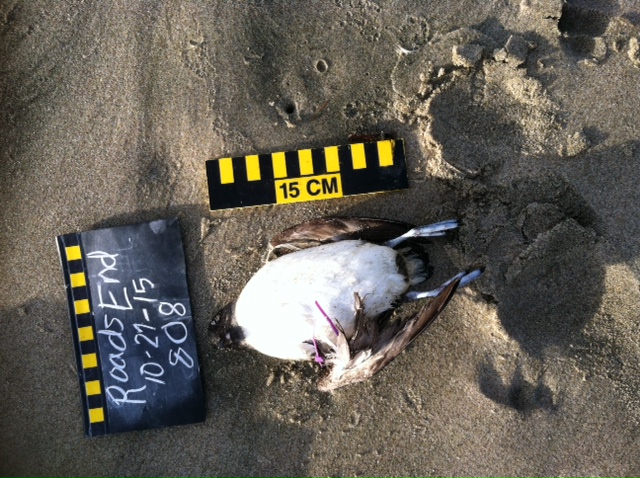 Bill: 20 mm, Wing: 12 cm, Tarsus: 25 mm
The Oregon Coast was flooded with these this week – “small birds with blue feet” – here’s one found by Laura and Caren at Roads End in Oregon.
Alaska foot key (page 34), West Coast foot key (page 22): webbed (go to Q2), completely webbed (go to Q3), 3 toes all webbed (go to Q4), tarsus <50mm, small foot – Alcids.
Page AL1: Wing chord <15cm = Small Alcids. Bill color dark with pale spot at base (look carefully!) – Cassin’s Auklet (WC: AL 8-9, or AK: AL21-22)
Bill: 20 mm, Wing: 12 cm, Tarsus: 25 mm
The Oregon Coast was flooded with these this week – “small birds with blue feet” – here’s one found by Laura and Caren at Roads End in Oregon.
Alaska foot key (page 34), West Coast foot key (page 22): webbed (go to Q2), completely webbed (go to Q3), 3 toes all webbed (go to Q4), tarsus <50mm, small foot – Alcids.
Page AL1: Wing chord <15cm = Small Alcids. Bill color dark with pale spot at base (look carefully!) – Cassin’s Auklet (WC: AL 8-9, or AK: AL21-22)
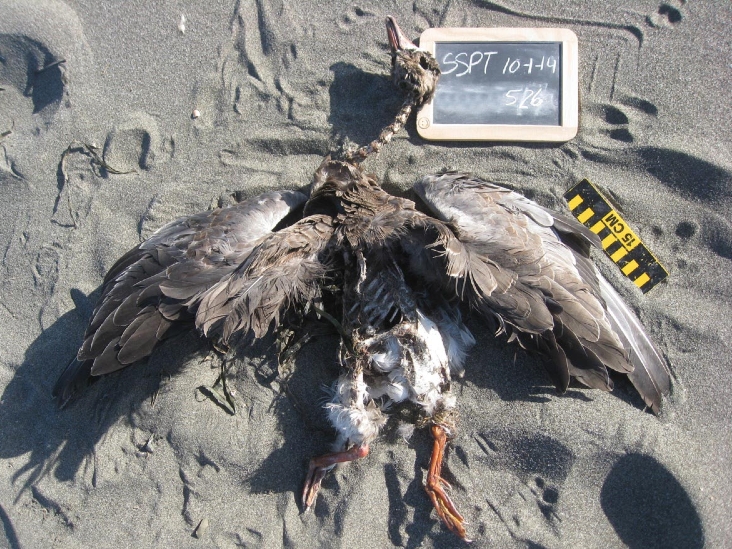
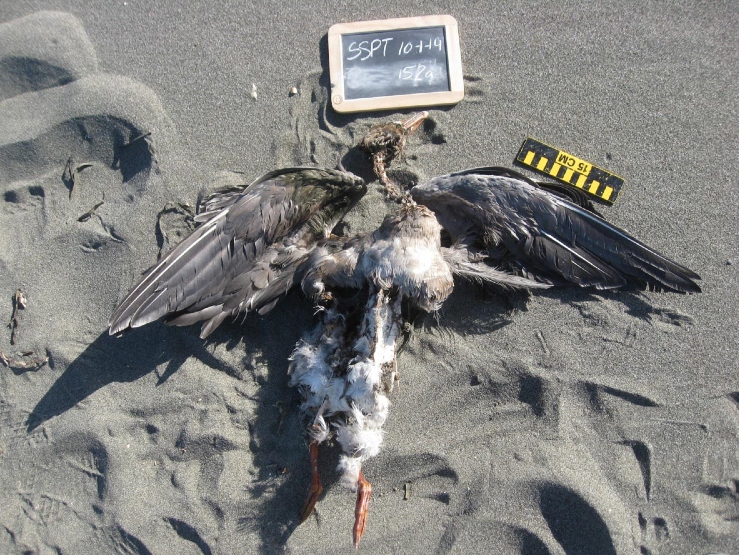 Bill: 50 mm, Wing: 42 cm, Tarsus: 73 mm
This bird was found by Don and Grace at South Spit in California on October 1st.
Alaska wing key (page 44):
Choose dark (go to Q2), dark (go to Q5), linings dark (go to Q9), primaries outercut, excluding outermost primary. Only one species fits – Greater White-fronted Goose – rare in Alaska.
West Coast wing key (page 33):
Choose dark (go to Q2), two or more thin white strips – Canada Goose or Greater White-fronted Goose. Canada Goose (WF19) has black feet – must be a Greater White-fronted.
OR
Choose mottled (go to Q14), choose mottling throughout (go to Q15), choose gray-to-dark underwing linings – Canada Goose or Greater White-fronted Goose. Canada Goose (WF19) has black feet – must be a Greater White-fronted.
Bill: 50 mm, Wing: 42 cm, Tarsus: 73 mm
This bird was found by Don and Grace at South Spit in California on October 1st.
Alaska wing key (page 44):
Choose dark (go to Q2), dark (go to Q5), linings dark (go to Q9), primaries outercut, excluding outermost primary. Only one species fits – Greater White-fronted Goose – rare in Alaska.
West Coast wing key (page 33):
Choose dark (go to Q2), two or more thin white strips – Canada Goose or Greater White-fronted Goose. Canada Goose (WF19) has black feet – must be a Greater White-fronted.
OR
Choose mottled (go to Q14), choose mottling throughout (go to Q15), choose gray-to-dark underwing linings – Canada Goose or Greater White-fronted Goose. Canada Goose (WF19) has black feet – must be a Greater White-fronted.
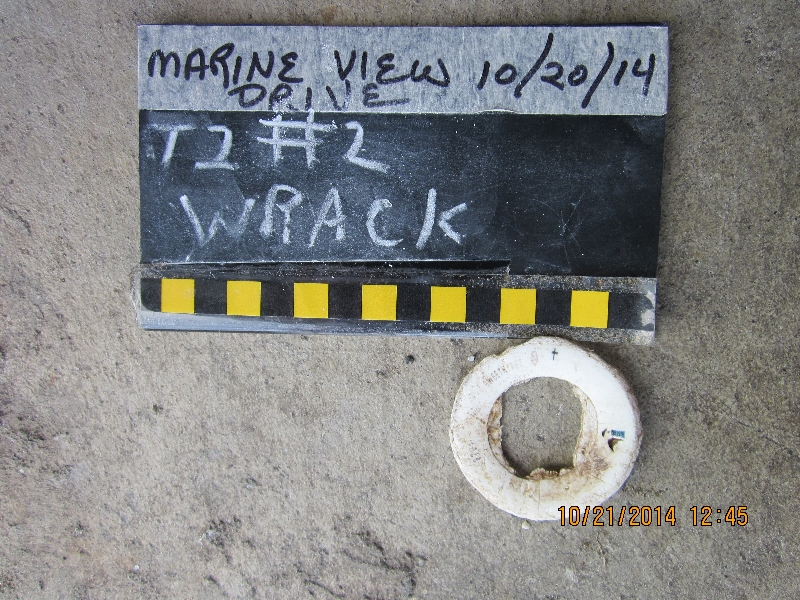
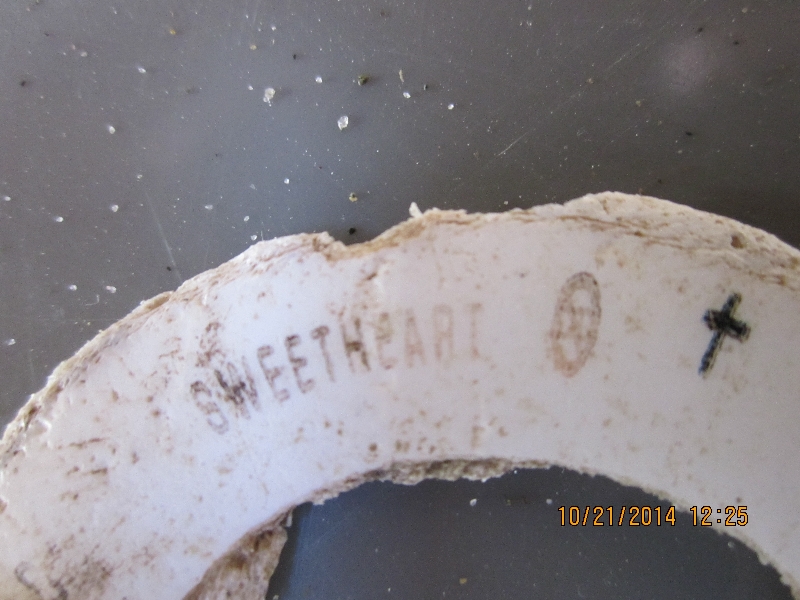 Marlene, one of our intrepid marine debris pilot testers, found this item. It is marked with “sweetheart” a cross, a couple of other unusual markings, and is just shy of 6cm in diameter. Anyone out there have a suggestion?
Marlene, one of our intrepid marine debris pilot testers, found this item. It is marked with “sweetheart” a cross, a couple of other unusual markings, and is just shy of 6cm in diameter. Anyone out there have a suggestion?
 Take a look at this gray whale that Candace found at Otter Point on October 15th. This whale is covered in barnacles and surrounded by footprints from all sorts of scavengers – birds, dogs, and maybe a few mustelids! You can also see rows of white baleen plates, used by gray whales to filter amphipods and other organisms out from the gulps of mud they take in while feeding.
Seen something on the beach you’ve always wondered about? Send us a photo!
Cheers,
Erika, Julia, Jane, Hillary, Charlie, Heidi, Jenn, and the COASST Interns
Take a look at this gray whale that Candace found at Otter Point on October 15th. This whale is covered in barnacles and surrounded by footprints from all sorts of scavengers – birds, dogs, and maybe a few mustelids! You can also see rows of white baleen plates, used by gray whales to filter amphipods and other organisms out from the gulps of mud they take in while feeding.
Seen something on the beach you’ve always wondered about? Send us a photo!
Cheers,
Erika, Julia, Jane, Hillary, Charlie, Heidi, Jenn, and the COASST Interns
